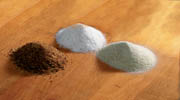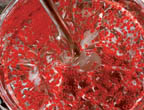Microencapsulation, the science of capturing a core material in a shell or coating for controlled release, can provide the food industry with a distinct market advantage in all these product purchase points. Microencapsulated products can add that extra zing, mask the taste of nutrients, alleviate processing problems, and increase the shelf life of food products.
Why Encapsulate?
Flavor, taste, and an appetizing appearance are primary factors in a consumer's decision to buy a product. Consider how the mouth-watering aroma of popcorn—microencapsulated for release during preparation—can improve sales. In addition, volatile colorants and aromas can be stabilized and their processing made simpler through microencapsulation.As consumers become increasingly health conscious, they are looking for more “functional foods”—many of which are augmented with ingredients to promote health. However, simply adding ingredients to food products to improve nutritional value can compromise their taste, color, texture, and aroma. Microencapsulation technology provides viable texture blending, appealing aroma release, and taste-, odor-, and color-masking. The technology enables food companies to incorporate minerals, vitamins, and essential oils, creating foods for the “wellness” market.
Microencapsulation can improve the convenience of food. The shell provides a barrier between reactive components (for instance, delaying the release of leavening agents for fluffier bread products or protecting oxygen-sensitive materials during processing and storage). Microcapsules can help fragile and sensitive materials survive processing and packaging conditions and stabilize the shelf-life of the active ingredient.
In addition, microencapsulation can simplify the food manufacturing process by converting liquids to solid powder, decreasing production costs by allowing batch processing using low-cost, powder-handling equipment. To improve food safety, the technology can be used to indicate product tampering, thermal spoilage, and freeze-thaw cycles.
With such a fascinating range of applications, no single “silver-bullet” microencapsulation process addresses all purposes. The dilemma is further complicated by the choices of shell formulations acceptable for foods, the desired stability and release characteristics and last, but never least, production costs.
Microencapsulation technology is sometimes considered more art than science, as stated by Asajo Kondo in Microcapsule Processing and Technology:

The challenges in developing a commercially viable product depend on:
- Selecting appropriate shell formulation from FDA-approved, GRAS (generally recognized as safe) materials,
- Selecting the most appropriate process to provide the desired morphology, stability, and release mechanism, and
- Economic feasibility of large-scale production, including capital, operating, and other miscellaneous expenses, such as transportation cost, regulatory cost, and downtime losses.
Microencapsulation Materials
Typically, microencapsulated products can be divided into five main categories: flavorings, vitamins and minerals, oils and fats (such as omega-3s and 6s), herbs and bioactives (such as creatine and probiotic bacteria), and other food ingredients (such as enzymes, leavening agents, psyllium and yeast).Shell Games
A critical step in developing microencapsulated food products is determining the shell formulation that meets the desired stability and release criteria. The GRAS shell material must stabilize the core material, must not react with or deteriorate the active ingredient, and should release under the specific conditions based on the product application.Shell materials are typically film-forming, pliable, tasteless, non-hydroscopic, soluble in an aqueous media or solvent, and/or exhibit a phase transition, such as melting or gel point.
Most materials approved for food use are natural or derivatives of a natural product. They can be put into roughly six categories as follows; this is not a comprehensive list. The FDA occasionally adds new GRAS materials, allowing researchers to revisit unsolved problems of the past.
- Polysaccharides/hydrocolloids, such as starch, algin/alginate, agar/agarose, pectin/polypectate, carrageenan, and other gums.
- Proteins such as gelatin, casein, zein, soy, and albumin.
- Fats and fatty acids such as mono-, di- and triglycerides, and lauric, capric, palmitic and stearic acid and their salts.
- Cellulosic derivatives such as methyl- and ethyl-cellulose and CMC.
- Hydrophilic and lipophilic waxes such as shellac, PEG (polyethylene glycol), or carnauba wax or beeswax.
- Sugar derivatives.
“Captivating” Techniques
The various microencapsulation processes allow product formulators to make capsules from less than a micrometer to several thousand micrometers in size. Each process offers specific attributes, such as high production rates, large production volume, high product yield, and different capital and operating costs. Other process variables include greater flexibility in shell material selection and differences in microcapsule morphology, particle size, and distribution.
Microencapsulation processes include both physical and chemical techniques. Physical methods use commercially available equipment to create and stabilize the capsules. Chemical techniques apply ionic chemistry to create the microspheres in batch reactors.

Other physical techniques include the spinning disc and coextrusion processes. The spinning disc method, similar to the spray-drying process, uses an emulsion or suspension containing the food ingredient, prepared with a solution or melt of the coating material. The emulsion or suspension is fed to the disc surface and forms a thin wetted layer that, as the disc rotates, breaks up into airborne droplets from surface tension forces that induce thermodynamic instabilities. Resulting capsules are typically spherical. Because the emulsion or suspension is not extruded through orifices, this technique permits use of a higher viscosity shell material and allows higher loading of the food ingredient in the shell. The process also offers a broad range of particle sizes with a controlled distribution.

The typical extrusion systems use stationary nozzle coextrusion, centrifugal coextrusion, or submerged nozzle coextrusion. All these processes involve concentric nozzles, which pump the core material through the inner nozzle while the shell formulation is pumped through the annulus, allowing true “core-shell” morphologies, unlike the previously described processes.
As the liquid stream exits the nozzle, local disturbances, such as induced vibration or gravitational, centrifugal, or drag force, control particle size. Typical microcapsules produced by coextrusion range from 100 micrometers to 6 mm, or about the size of a human egg cell to the size of a pencil eraser.
Of the different chemical microencapsulation processes, only phase separation, gelation, and coacervation are widely used in the food industry. All chemical methods are batch processes, although the research community is mounting considerable effort to make them continuous. In phase separation, the food ingredient, such as flavor oil, is emulsified in a polymer solution, and subsequently, an antisolvent is added to induce the precipitation of the polymer around the core. In coacervation, microcapsule shells are formed by ionic interaction between two ionic polymers, typically a polyanion (acacia gum) and a polycation (gelatin). The concept of gelation as a microencapsulation method involves using a technique such as cooling, crosslinking, or a chemical reaction to form gelled microspheres or microcapsules. For example, reacting sodium alginate with calcium chloride forms the insoluble calcium alginate.
Microencapsulation technology remains something of an art, although firmly grounded in science. Combining the right shell materials with the most efficient production process for any given core material and its intended use requires extensive scientific knowledge of all the materials and processes involved and a good feel for how materials behave under various conditions.
As the interest in “wellness” foods or “nutraceuticals” grows, microencapsulation will play a key role in putting the function in functional foods, without sacrificing smell, taste, or convenience.

Sidebar: Better Products Through Encapsulation
HeartBar®, manufactured by Unither Pharmaceuticals, Silver Springs, Md., is a line of dietary supplements and medical foods that benefit cardiovascular health. The key ingredient, L-arginine, is a bitter-tasting amino acid. A good-tasting and good-for-you product is achieved by encapsulating this bioactive compound.Somewhat similarly, encapsulation of nutritional dietary fibers prevents these ingredients from producing an undesirable increase in a product's viscosity. The fibers are then designed to be released once they reach the human digestive tract.
Examples of other foods that rely on encapsulated ingredients include Red Baron's Bake To Rise® pizza from Schwan's Consumer Brands, Bloomington, Minn. There, the action of sodium bicarbonate is delayed until needed in the oven.
www.unitherpharma.com
www.redbaron.com/products_pizzabake.asp